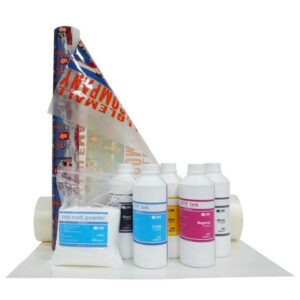DTF Transfer printing has become popular because of its high-quality output and adaptability. However, users have complained that DTF Transfer doesn’t stick properly, resulting in unsatisfactory prints and wasted resources. Those that depend on DTF Transfer for their professional or personal tasks may find this problem to be inconvenient. DTF transfer not sticking may result in large financial losses and lost time spent trying to solve the issue. This blog article will examine potential causes of adhesion failures and provide remedies to enable customers to print successfully. By understanding the reasons of this issue and executing efficient remedies, consumers may save time, money, and materials and get DTF Transfer’s high-quality prints.

Possible reasons for DTF Transfer not sticking
Inadequate pre-treatment of the substrate
One potential cause of DTF Transfer’s poor adhesion is inadequate substrate pre-treatment. DTF Transfer requires substrate pre-treatment to make the surface ink- or powder-receptive. If the substrate is not adequately pre-treated, it may not bind with the ink or powder, resulting in poor adherence.
Not applying enough adhesive, using the improper adhesive for the substrate, or not letting the glue cure before printing are frequent substrate pre-treatment concerns. Moreover, certain substrates can need more than one adhesive application or a different pre-treatment technique altogether.
To fix this, pre-treat the substrate according to the manufacturer’s instructions and clean and dry it before applying the adhesive. It’s crucial to apply the proper kind and quantity of adhesive for the chosen substrate. These methods enable users pre-treat the substrate and stick the DTF Transfer the right way.
Poor quality DTF powder or ink

DTF Transfer may not stick effectively owing to low-quality DTF powder or ink. Low-quality powders or inks might not have the right properties to stick to the substrate well, which can lead to poor adhesion and bad prints.
Low-quality powders and inks may adhere poorly due to uneven particle sizes or inappropriate formulation. Expired powders or inks may also affect adherence.
It’s essential to apply top-notch DTF powders or inks in order to solve this problem. Get powders and inks from trusted providers and verify expiry dates and quality standards. To preserve powders and inks, users should follow the manufacturer’s storage and usage instructions.
Issues with the printing process
DTF Transfer sticking might fail due to printing issues. Temperature, humidity, pressure, and print parameters impact transfer adherence during printing.
The adhesive may not activate correctly if the temperature or humidity is too low. The transfer will not bind well with the substrate if the pressure is too low. Poor adhesion may also be caused by faulty print settings, such as using the wrong ink type or the inappropriate curing durations.
Optimizing the printing procedure for the substrate and DTF Transfer will solve this problem. The manufacturer’s recommendations for printing parameters, including temperature, humidity, pressure, and curing durations, should be followed by users. For best adherence, you may need to experiment with settings.
Substrate-related issues
DTF Transfer sticking problems can happen due to substrate related issues. The ability of various substrates to connect with DTF powder or ink might vary depending on their unique features. As an example, substrates with a rough or uneven surface could not bind well with the transfer, leading to poor adherence. Similar to substrate porosity, transfer adhesion may vary.
To fix this, pick the proper substrate for the DTF Transfer. Users should use DTF Transfer-friendly substrates that are clean and debris-free. For the substrate to adhere well, it can also be required to pre-treat it or use a different adhesive. Users may improve DTF Transfer adhesion and print quality by resolving substrate concerns.
Environmental factors
Moreover, environmental conditions can contribute to DTF Transfer not adhering adequately. As an example, excessive humidity levels might make the adhesive overly moist, which will result in poor adherence. Similar to low humidity levels, excessive drying of the adhesive may also lead to poor sticking.
Temperature and air flow are two additional environmental variables that might impact printing and ultimately the transfer’s adherence. For instance, if the temperature is too low, the adhesive may not work effectively, and if it’s too high, the transfer could melt or distort.
It’s crucial to adapt the printing environment to the particular DTF Transfer in question in order to solve this problem. To avoid overheating or over-drying, users should make sure that the temperature and humidity levels are within the prescribed range and that there is enough airflow. Environmental conditions may need printing adjustments.
Solutions to DTF Transfer not sticking
Ensuring proper pre-treatment of the substrate
To fix insufficient substrate pre-treatment, follow the manufacturer’s substrate preparation instructions and make sure the substrate is clean and dry before applying the adhesive. Also, users should apply the right kind and quantity of adhesives for the particular substrate they are working with. In rare circumstances, it could be essential to use more than one layer of adhesive or a different pre-treatment technique.
Regularly testing and replacing low-quality DTF powder or ink
It’s critical to get DTF powder or ink from reliable providers and to look for any expiry dates or quality certificates in order to handle the problem of subpar DTF powder or ink. Users must examine the powders or inks often to make sure they are functioning correctly and should replace any that are discovered to be of poor quality or to have expired.
Choosing the right substrate for the DTF Transfer
Use the correct substrate for the DTF Transfer to avoid substrate difficulties. Users should use substrates that are well-known to function with DTF Transfer and make sure the substrate is clear of any impurities or debris. To get the best adhesion, it could also be required to pre-treat the substrate or use a different adhesive.
Optimizing the printing process
It’s crucial to adjust the printing environment and parameters for the particular substrate and DTF Transfer being utilised in order to handle printing-related concerns. Users should adhere to the manufacturer’s recommendations for printing parameters, including as temperature, humidity, pressure, and curing durations. It’s possible that users may need to experiment with various parameters to get the best adhesion.

How to Optimize?
Tuning the printing process is essential for DTF Transfer sticking. While enhancing the printing process, it’s important to take into account a number of important elements, including:
Temperature: What temperature should DTF be pressed at? The DTF printing environment’s temperature impacts how well the DTF Transfer adheres to the surface. Users need to make sure the temperature is within the acceptable range for the particular transfer they are using. If the temperature is too high, the transfer may melt or distort, while if it is too low, the adhesive may not work as intended.
Humidity: The adherence of the DTF Transfer might also be impacted by humidity conditions. Low humidity might dry up the adhesive, while high humidity can make it overly moist. Users need to make sure the humidity is within the acceptable limit for the particular transfer they are using.
Pressure: The pressure used during the printing process may have an impact on the transfer’s ability to adhere. Users should make sure the pressure is just right to activate the adhesive and adhere the transfer to the substrate without melting or warping it.
Curing time: The amount of time the adhesive needs to properly activate and adhere the transfer to the substrate is referred to as the “curing time.” In order to thoroughly cure the transfer before removing the backing sheet, users should follow the manufacturer’s instructions for the required curing period.
Optimizing the printing process may help users get good DTF Transfer adhesion and high-quality prints. To identify the best printing settings for the particular transfer and substrate you’re using, it is critical to experiment with several settings.
Why is my heat transfer not sticking to shirt?

Heat transfer that doesn’t attach to the shirt frustrates both rookie and professional printers. There are a number of reasons why this could occur, including:
- Incorrect temperature or pressure: Inappropriate temperature or pressure is one of the most frequent causes of heat transfer failure to adhere to the garment. The transfer will not stick to the shirt adequately if the temperature or pressure are too low. High pressure or temperature might burn or distort the DTF transfer.
- Poor transfer paper: Improper transfer paper is another factor contributing to heat transfer not adhering to the shirt. Low-quality transfer paper might result in the transfer peeling off the shirt, the ink bleeding, or the paper sticking to the shirt instead of the ink.
- Dirty or contaminated shirt: T-shirt that is unclean or polluted with oil, dirt, or other contaminants may not allow the transfer to adhere correctly. Before putting the transfer on the garment, make sure it is spotless and free of any dirt or impurities.
- Incompatible fabric: Certain textiles, like nylon or polyester, need for unique transfer paper and ink formulas. Wrong transfer paper and ink may affect fabric adhesion.
How to press DTF transfers?
To ensure that the DTF (Direct-to-Film) transfer sticks correctly to the substrate, pressing requires a number of processes. The basic procedures for pressing DTF transfers are as follows:
- Pre-treating the substrate is essential to increase adhesion, depending on the kind of substrate you use. Pre-treatment processes include priming, adhesive coating, and pre-treatment solutions.
- Print the DTF transfer: Use a suitable printer and DTF ink to print the DTF transfer. Since the transfer will be put face down to the substrate, be sure you mirror the image before printing.
- Cut out the transfer: From the printed sheet, cut out the transfer using a cutting instrument like a plotter or scissors.
- Put the transfer on the substrate: Make sure the transfer is positioned properly by placing it face down on the substrate.
- To press the transfer, cover it with a Teflon sheet and use a heat press. The transfer and substrate determine the appropriate temperature and pressure. We can press the DTF transfers for 25–30 seconds at a pressure of 30–40 psi at a temperature of 320–340°F (160–170°C).
- After pressing, remove the Teflon layer, and while the transfer paper is still warm, gently peel it away from the substrate. Repeat the pressing procedure with a higher temperature or pressure if any sections of the transfer are not well attached.
- Post-treat the transfer to increase washability or durability, depending on the transfer and substrate.
How long to press DTF transfers?
DTF (Direct-to-Film) transfer pressing times vary per transfer and substrate. But between 25 and 30 seconds is usually the best time for pressing DTF transfers.
Conclusion | DTF Transfers Sticking Problems
DTF transfers are a high-quality, long-lasting heat transfer option. To get the intended outcome, it is crucial to make sure the transfer sticks to the substrate adequately. Users may optimise DTF transfer adhesion by pre-treating the substrate, utilising high-quality DTF powder or ink, optimising the printing process, selecting suitable substrates, and managing environmental conditions. Following the proper pressing time, temperature, and pressure may also optimise DTF transfers. You can determine the best settings for DTF transfer and substrate by testing.
FAQs
A DTF transfer may not adhere to the substrate for a variety of reasons, such as insufficient substrate pretreatment, subpar DTF powder or ink, printing process problems, substrate-related problems, and environmental conditions.
Pre-treating the substrate using a pre-treatment solution, base coat, or heat press before applying the transfer is important. Follow the manufacturer’s pre-treatment technique & instructions.
If your transfer doesn’t stick despite utilising high-quality DTF powder or ink, you may need to change the substrate pre-treatment, printing method, or pressing conditions.
Indeed, humidity and temperature influence DTF transfer adhesion. To achieve the best adhesion, it is crucial to regulate these elements as much as you can.
If your DTF transfer doesn’t stick after trying multiple treatments, consider a new transfer or substrate. Moreover, speaking with a DTF transfer specialist or getting assistance from other users may be beneficial.

Ashley Wang is a skilled sales manager with knowledge in DTF printing. She presently works for ShenLan Digital, a reputable DTF printer maker. Ashley is the best person to offer advice on selecting the most suitable DTF printer because she has tested a lot of them. She launched DTFPrinterSchool to educate individuals and organizations about DTF printing technology, providing her expertise and observations on the most recent advancements in the sector. Ashley is an invaluable resource for businesses and individuals wishing to invest in DTF printing technology because of her expertise and experience in the industry.
